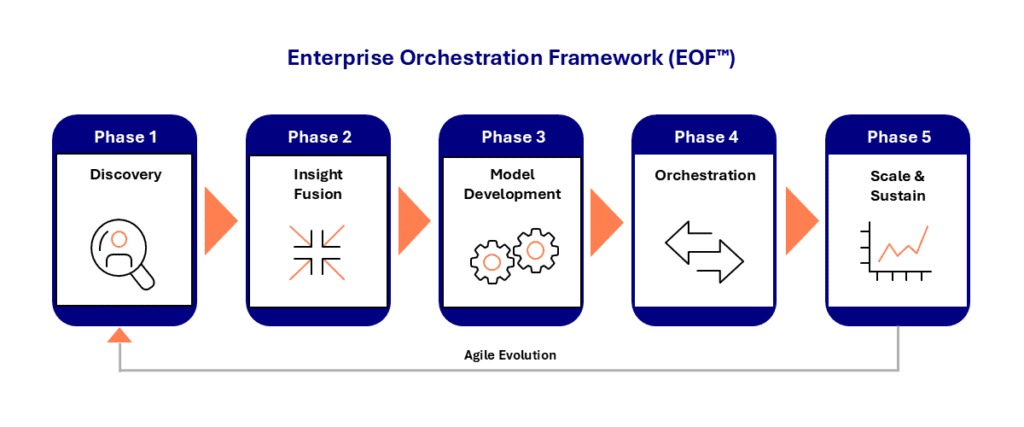In Brief
- ERP’s Past vs. Present Needs – Traditional ERP systems unify processes yet preserve silos, leading to local optimization but often undermining enterprise-level synergy. The Watermelon Principle highlights how departmental metrics can glow reassuringly green while broader organizational performance is ominously red.
- No Silo Left Behind – By combining local AI agents (tailored to functional expertise) with an enterprise orchestrator AI, organizations integrate intelligence. This multi-agent approach enables real-time cross-functional coordination and preserves human oversight through carefully managed overrides.
- EOF™ for Full Orchestration – The five-phase Enterprise Orchestration Framework (EOF™) lays out a structured path—Discovery, Insight Fusion, Model Development, Orchestration, and Scale & Sustain—to deploy AI across silos. It aligns incentives, measures override outcomes, and ensures that each departmental success also advances the company’s overarching goals.
Enterprise Resource Planning (ERP) emerged in the 1990s as a unifying force for previously disconnected organizational functions, including finance, operations, procurement, and human resources. By consolidating data in a single system of record, ERP systems replaced scattered spreadsheets, introduced consistency, and offered insights previously unavailable across siloed departments. Over the ensuing decades, ERP became the bedrock of enterprise operations, from multinational manufacturers to local service providers. Yet, by 2025, analysts noted a persistent shortfall in achieving KPIs and OKRs; many ERP implementations—estimates often suggest around 70%—fall short of delivering genuine cross-silo synergy, highlighting the urgent and pressing need for change.
The core issue is not about how effectively ERP tracks transactions, but about how it fails to orchestrate intelligence across the entire enterprise. By reflecting departmental boundaries in its very architecture, ERP supports the optimization of silos instead of truly integrating them. This mismatch becomes especially evident when organizations face fluid market demands, complex global supply chains, and rapid strategic pivots that require immediate cross-departmental alignment. Gryphon Citadel’s “Watermelon Principle” crystallizes the problem: each department’s metrics can glow reassuringly green on the surface, while enterprise-wide performance remains ominously red at the core.
A new approach is required—one that transcends integrated software to deliver integrated enterprise intelligence. Gryphon Citadel’s vision under the banner of “No Silo Left Behind” recognizes the limits of ERP’s silo-based architecture. It proposes the orchestration of departmental AI agents, guided by enterprise orchestrator intelligence, to ensure balanced, enterprise-level outcomes. At the heart of this approach lies the Enterprise Orchestration Framework (EOF™), a structured methodology for systematically implementing and scaling artificial intelligence across silos.
The Watermelon Principle – When Green Hides Red
Though ERP standardizes processes and centralizes data, it remains tethered to departmental or functional modules. Marketing, finance, supply chain, and HR may each utilize powerful ERP functionalities; however, these modules rarely, if ever, coordinate decisions in real-time. This fragmentation explains why dashboards appear a vibrant green for each function, even when overall corporate performance suffers.
Consider a hypothetical manufacturer, GlobalCo, which has successfully executed a marketing campaign, maintains healthy financial margins, and boasts a 98% delivery timeliness rate in its operations. Customers, however, experience long wait times for popular items, while supply chain managers struggle with sudden demand surges, and finance teams quietly adjust margins to meet the new demands.

Each ERP module demonstrates local excellence, yet the enterprise is far from optimal. The Watermelon Principle captures that tension – green on the outside, red on the inside. This principle is akin to a watermelon that appears ripe and healthy on the outside, representing the success of the individual department. However, when you cut it open, it reveals a red interior, representing the overall corporate performance. In simpler terms, it’s like a fruit that looks good on the outside but is not ripe on the inside. This analogy highlights the disconnect between individual departmental success and the overall corporate performance, a key issue in many ERP implementations.
Silo persistence stems as much from organizational behavior as from technology. Departments often protect data and autonomy, inadvertently reinforced by ERP’s module-based design. Leaders assume that having a single software platform equates to synergy, missing how each silo can still chase function-specific goals at the expense of corporate priorities. The solution lies in orchestrated, cross-silo intelligence that sees the entire playing field, not just one department’s corner. This underscores the crucial role of leadership in driving cultural change and the significance of their role in the proposed transformation.
Evolving from Integrated Systems to Integrated Intelligence
ERP’s strength lies in its ability to unify transactional systems, provide standardized reporting, and improve operational consistency. Yet, this design focuses on managing processes rather than coordinating decisions. ERP might dutifully log a marketing spike in product demand, but the system itself does not orchestrate finance, operations, or logistics to handle the surge. In a world where real-time adaptability trumps static planning, ERP’s retrospective and silo-bound architecture reveals its limitations.
Artificial intelligence (AI) is uniquely positioned to address these shortcomings by integrating data streams from every function and synthesizing predictive, holistic insights. Where ERP excels at structure and record-keeping, AI specializes in context and foresight. By combining local AI agents, trained on departmental data, with an enterprise orchestrator AI that mediates these local optimizations against broader organizational KPIs, the business can finally strike a balance between local depth and enterprise cohesion. This balance encapsulates “No Silo Left Behind”. Each function’s achievements matter only in service to the enterprise’s integrated objectives, paving the way for a more efficient and effective future of ERP, filled with the promise of AI-driven insights and collaboration, and inspiring a sense of optimism for the future.
Local Decision Intelligence Agents vs. the Enterprise Orchestrator
Departments often adopt AI tailored to their specific domains. Finance may have a predictive cost model, marketing may have a campaign optimization engine, and operations may have a production scheduling agent. Without an enterprise orchestrator, however, these local AI efforts can foster silo-based thinking, thereby boosting departmental metrics at the expense of cross-functional efficiency. An enterprise orchestrator connects these local agents, reconciling conflicting goals and recommending decisions in line with overall corporate KPIs. For example, marketing’s AI might plan a promotion that outstrips production capacity. An enterprise orchestrator AI predicts that clash, weighs the financial repercussions, and proposes an optimal path. Human leaders, particularly those in local departments, retain the capability to override. They may accept or reject the orchestrator’s guidance, providing feedback on outcomes to refine both local and enterprise-level models. Empowering human leaders in the AI decision-making process is crucial for an enterprise’s success, as it enables the consideration of real-world insights and facilitates necessary changes, thereby empowering them as an integral part of the process.
Introducing the Enterprise Orchestration Framework (EOF™)
Unifying AI and ERP to Optimize the Enterprise
Many organizations struggle with fragmented AI deployments and siloed ERP modules that fail to align with enterprise-wide goals. The Enterprise Orchestration Framework (EOF™) addresses this challenge head-on. It offers a structured, five-phase approach for implementing and scaling AI across complex enterprises, ensuring that local agent optimizations contribute to a coherent and orchestrated enterprise perspective.

By embedding orchestration logic directly into operations, EOF™ helps organizations move beyond departmental automation to a fully coordinated, AI-augmented enterprise. This framework not only accelerates time-to-value for AI investments but also builds long-term capabilities for adaptive, cross-functional decision-making.
Discovery
- Align Stakeholders: Form a cross-functional oversight group that includes representatives from finance, operations, marketing, HR, and data science. This group will be responsible for overseeing the implementation of the EOF, ensuring that it aligns the departmental KPIs with overarching corporate objectives. They will also play a crucial role in resolving any conflicts that may arise during the implementation process.
- Map the Ecosystem: Identify high-friction workflows, such as product launches, invoice reconciliation, or demand forecasting, as well as existing departmental AI initiatives that currently run in isolation. For instance, marketing may have a predictive cost model, finance may have a campaign optimization engine, and operations may have a production scheduling agent. Compare current states with future-state visions of integrated orchestration.
- Locate Silo Boundaries: Explore how ERP modules reflect departmental divides, highlighting friction points such as tariffs, force majeure events, or product recalls.
Insight Fusion
- Establish Governance: Ensure data permissioning and security standards protect departmental autonomy while allowing the orchestrator and local AI agents to access relevant information without cultural or political roadblocks.
- Aggregate Data: Merge ERP logs, CRM data, and external signals (market, social, and competitor) in a central repository, enabling the enterprise orchestrator to view the broader picture.
- Develop Minimum Viable Insights (MVIs): Run small proof-of-concept models that illustrate immediate cross-silo benefits, such as linking logistics constraints to marketing campaigns to enable an incremental path to larger implementations.
Model Development
- Build Local vs. Enterprise Models: Let each department refine its own AI agent while simultaneously training an enterprise orchestrator AI that unifies recommendations.
- Define Override Mechanisms: Hard-code the possibility for local managers to override decisions made by the enterprise orchestrator. Introduce the concept of logging these overrides to measure outcomes and capture the projected value presented by a prediction or simulation, assuming the local manager accepts the recommendation. Providing invaluable data for reinforcement learning.
- Advanced Maturity: Move from descriptive analytics toward prescriptive and orchestrated capabilities, constantly checking for hidden biases, ethical constraints, and domain-specific nuances.
Orchestration
- Embed in Daily Operations: The enterprise orchestrator AI continuously reconciles local agent outputs, offering real-time suggestions that transcend departmental silos and reinforce enterprise broad objectives.
- Cross-Functional KPIs: Elevate synergy metrics (like order-to-cash cycle time or net margin improvement) that reflect enterprise-level success, not just functional gains.
- Override Logging and Incentives: Enable managers to override orchestrator guidance when they possess local insights that the AI might lack. Document each override, measure its outcome, and adjust the models accordingly. Reward local managers whose overrides consistently uplift overall KPIs, thus refining both local and enterprise logic.
Scale and Sustain
- Institutionalize AI Governance: A permanent oversight council monitors repeated override scenarios, addresses departmental misalignments, and updates AI logic.
- Track Convergence: Use a Silo Convergence Index to gauge how frequently departmental decisions incorporate enterprise orchestrator recommendations. Adverse override outcomes might signal data gaps; positive ones highlight domain expertise.
- Refine Incentive Structures: Periodically recalibrate compensation and recognition programs to ensure that cross-functional collaboration becomes the norm and that local domain wins do not undermine enterprise goals.
Overrides, Incentives, and the Human in the Loop
Overrides serve as a central pivot where local and enterprise perspectives converge. A local finance lead might, for instance, override a recommended marketing spend if the orchestrator’s decision seems inconsistent with upcoming liquidity constraints. Each override is recorded, specifying the reasoning and eventual performance. The system learns from these override results, updating local agents or the enterprise orchestrator AI with newly uncovered real-world constraints. When overrides may outperform enterprise orchestrator guidance, the enterprise gains domain knowledge that it can incorporate into future logic in a continuous improvement (“learning”) loop. Conversely, overrides that erode enterprise metrics prompt deeper evaluation of departmental motivations or potential data deficiencies.
An override mechanism must align closely with a well-crafted incentive structure. If departmental heads are solely rewarded for improving local metrics, they might override enterprise orchestrator proposals for short-term, silo-bound benefits. Organizations can combat this risk by tying a significant portion of bonuses or performance reviews to overall margin, on-time delivery, or Net Promoter Scores—metrics that reflect synergy rather than isolated optimization. This shift ensures each departmental leader becomes a guardian of enterprise performance. Overrides are no longer merely about championing local interest; they are about refining multi-agent AI logic in ways that benefit the entire business.
Leadership and Cultural Shifts
Transforming organizations from siloed entities into orchestrated ecosystems requires intentional leadership intervention. Leaders must consistently reinforce systemic thinking, emphasizing enterprise-wide KPIs over silo-specific metrics. They should appoint cross-functional stewards for AI governance, clearly communicate strategic vision, and incentivize collaborative behavior across departments. Through leadership’s intentional focus, organizations can cultivate a culture embracing enterprise decision intelligence.

In Switch: How to Change Things When Change Is Hard, Chip and Dan Heath demonstrate that lasting change requires engaging both the rational and emotional aspects of human behavior. They use the metaphor of the “Rider” for the analytical mind and the “Elephant” for the emotional core. Rational arguments—like the business case for cross-silo AI—speak to the Rider. Yet without energizing the Elephant through stories, tangible wins, and a sense of purpose, even the most logical plans often stall.
For “No Silo Left Behind” to gain real traction, leaders must appeal to both: offering clarity and data-driven rationale (the Rider) while motivating teams across finance, operations, HR, and marketing to embrace and trust the enterprise orchestrator (the Elephant). When logic and emotion move in harmony, teams are more open to new AI-driven workflows and override mechanisms, accelerating cultural buy-in and enabling cross-silo coordination to flourish.
Introducing local decision intelligence agents, an enterprise orchestrator, and structured overrides requires a cultural pivot. Leaders should emphasize a “No Silo Left Behind” mindset, promoting transparency, data-sharing, and an eagerness to reconcile conflicting aims under enterprise objectives. They must also sponsor AI literacy programs so that managers across departments understand why and how orchestrator guidance arises, fostering a healthy balance between automated insights and human expertise.
Trust is essential. Departments might worry that an enterprise orchestrator will prioritize abstract corporate metrics over local needs, or that overrides will be penalized bureaucratically. Leaders can dispel such fears by publicizing examples of how successful overrides enhance overall outcomes and offering appropriate rewards and recognition. Transparency around override results—both successes and failures—cements this trust, as it clarifies the interplay between local domain wisdom and orchestrator logic.
Achieving No Silo Left Behind
ERP changed how businesses integrate processes, yet it lacked the adaptive intelligence to unify decisions. The “No Silo Left Behind” philosophy advances beyond integrating software to integrating decision intelligence at an organizational scale. AI becomes the catalyst: local agents safeguard each department’s specialized interests, while an enterprise orchestrator, guided by the EOF, ensures synergy at higher levels. Overrides, tracked diligently through measured incentive frameworks, allow human domain expertise to refine AI predictions rather than blindly follow them.
Under this structure, the Watermelon Principle loses its force, as departmental gains cannot mask enterprise-level dysfunction. The entire ecosystem of decisions moves in unison, with ERP’s transactional rigor reinforced by an orchestrated AI layer that scans for friction, highlights potential misalignments, and fosters shared accountability across departments. By methodically applying the five phases of the Enterprise Orchestration Framework (EOF™), organizations evolve ERP from an operational mainstay into a living, breathing center of orchestrated enterprise decision intelligence. Each function’s local mastery is celebrated, but never at the cost of enterprise cohesion. The ultimate promise is a genuinely collaborative and proactive business environment in which all silos align under a single banner of progress—ensuring no silo is left behind.
As you stand on the threshold of the next wave in digital transformation, the real question isn’t whether you can integrate AI into your operations, but whether you can use it to help unify goals, objectives, and outcomes across your entire enterprise. “No Silo Left Behind” is more than a catchphrase; it’s a rallying point for the future. By anchoring AI at the core of your strategy and ensuring it flows through and interconnects every division, you create a more intelligent and cohesive organization. Now is the moment to transcend piecemeal optimizations and seize a holistic advantage that only cross-silo intelligence can deliver. In a world short on patience and long on expectations, your willingness to act today will determine whether you merely adopt AI—or harness it to redefine what’s possible.
Related articles:
Matthew (“Matt”) Gorman, a Manager at Gryphon Citadel, played a key role in developing this article. He brought a wealth of experience in AI, ERP, and enterprise transformation. His insights, gained from extensive work in complex and regulated industries, helped clarify how intelligent systems can create significant impacts across different silos.
About Gryphon Citadel
Gryphon Citadel is a management consulting firm based in Philadelphia, PA. Known for our strategic insight, our team delivers invaluable advice to clients across various industries. Our mission is to empower businesses to adapt and flourish by infusing innovation into every aspect of their operations, leading to tangible, measurable results. Our comprehensive service portfolio includes strategic planning and execution, digital and organizational transformations, performance enhancement, supply chain and manufacturing optimization, workforce development, operational planning and control, and advanced information technology solutions.
At Gryphon Citadel, we understand that every client has unique needs. We tailor our approach and services to help them unlock their full potential and achieve their business objectives in the rapidly evolving market. We are committed to making a positive impact not only on our clients but also on our people and the broader community. At Gryphon Citadel, we transcend mere adaptation; we empower our clients to architect their future. Success isn’t about keeping pace; it’s about reshaping the game itself. The question isn’t whether you’ll be part of what’s next—it’s whether you’ll define it.
Our team collaborates closely with clients to develop and execute strategies that yield tangible results, helping them to thrive amid complex business challenges. Let’s set the new standard together. If you’re looking for a consulting partner to guide you through your business hurdles and drive success, Gryphon Citadel is here to support you.
Explore what we can achieve together at www.gryphoncitadel.com


